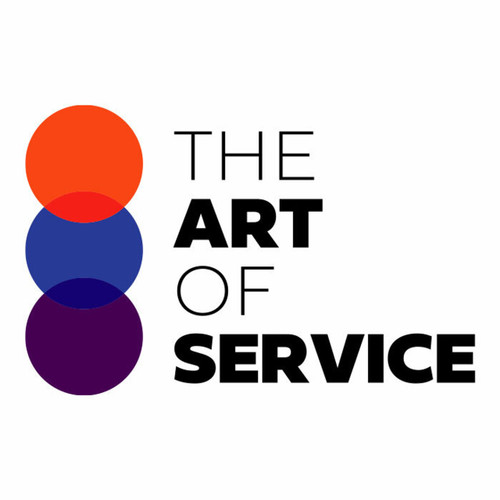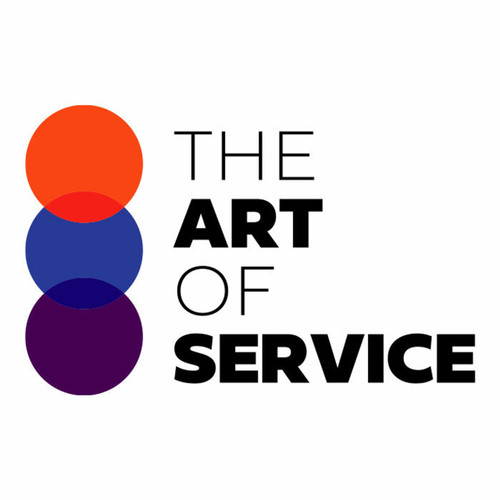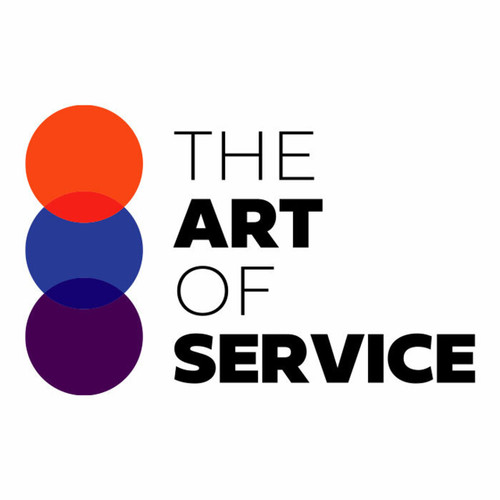Are you tired of wasting time sifting through endless resources and information to find the answers to your most pressing Information Technology and Customer Service Excellence questions? Look no further than our comprehensive Knowledge Base, designed to provide you with the most important questions to ask in order to achieve results based on urgency and scope.
Our dataset contains a whopping 1547 prioritized requirements, solutions, benefits, and results for Information Technology and Customer Service Excellence.
But what sets us apart from our competitors and alternative products? Our data is specifically tailored for professionals like you, making it the perfect tool for your business needs.
Our easy-to-use product includes an overview of Information Technology and Customer Service Excellence, its benefits, and real-life case studies/use cases.
You can trust that our dataset is thoroughly researched and covers all aspects of Information Technology and Customer Service Excellence to ensure your business stays ahead in the ever-evolving digital landscape.
But that′s not all - our product offers a more affordable and DIY alternative compared to other similar options.
Plus, the detailed specifications and product type make it easy for you to identify the best strategies for your specific business needs.
Don′t let your business get left behind in the world of Information Technology and Customer Service Excellence.
Invest in our Knowledge Base and see the immediate benefits for yourself.
Say goodbye to wasted time and hello to efficient and effective solutions for your business.
Try it out today and experience the advantages for yourself.
Don′t hesitate, act now!
Discover Insights, Make Informed Decisions, and Stay Ahead of the Curve:
Key Features:
Comprehensive set of 1547 prioritized Information Technology requirements. - Extensive coverage of 159 Information Technology topic scopes.
- In-depth analysis of 159 Information Technology step-by-step solutions, benefits, BHAGs.
- Detailed examination of 159 Information Technology case studies and use cases.
- Digital download upon purchase.
- Enjoy lifetime document updates included with your purchase.
- Benefit from a fully editable and customizable Excel format.
- Trusted and utilized by over 10,000 organizations.
- Covering: Brand Excellence, Digital Supply Chain, Empowering Employees, New Employee Orientation, Driving Excellence, Supplier Quality, Listening Skills, Customer Centric Approach, Escalation Management, Customer Service Culture, Voicemail Messages, Customer Acquisition Strategies, Continuous Improvement Communication, Customer Satisfaction, Ongoing Training, Customer Empathy Training, Service Response Time, Decision Making, Quality Function Deployment, Understanding Customer Needs, Inbound Call Management, Sales And Upselling, Defining Values, Held Calls, Customer Driven, Customer Feedback Management, Customer Relationship Enhancement, Efficiency Reporting, Service Desk Excellence, Group Fairness, Call Monitoring, Staff Motivation, Information Technology, Productivity Rates, Shingo Prize, Process Optimization Tools, Customer Driven Solutions, Up To Date Technology, Time Management, Service Recovery, Demand Variability, Customer Trends, Removing Barriers, Continuous Improvement, Resolving Customer Complaints, Productivity Tracking, Responsive Communication, Service Excellence, Defect Rates, Process Enhancements, Tailored Communication, Hierarchical Communication, Customer Focus, Digital Workflow Management, Service Speed, Long Term Partnerships, Stakeholder Communications, De Escalation Techniques, Influencing Skills, Voice of the Customer, Customer Success Strategies, Active Listening, Trust Building, Business Process Redesign, Service Delivery Improvement, Encouraging Diversity, Customer Engagement Tracking, Customer Experience Management, Process Complexity, Transportation Economics, Regulators Expectations, Communication Improvement, Transparent Culture, Customer Oriented, New Market Penetration, Handling Objections, Consistent Communication, Knowledge Of Products, Personalized Service, Handling Returns, Customer Service Training, Reacting To Challenges, Benchmarking And Best Practices, Efficient Resource Allocation, Customer Communication Strategies, Tone Of Voice, Negotiation Skills, Complaint Handling, Handling Emotions, Customer Complaints, Questioning Skills, Building Rapport, Stress Management, Customer Service Goals, Process Optimization Teams, Positive Language, Quality Control Culture, Urgency Management, Involvement Culture, Service Scalability, Customer Complaint Resolution, Service Desk Support, Scheduling Optimization, Human Rights Policies, Regulatory Compliance, Customer Service Metrics, Custom Workflows, Problem Solving Skills, Agent Training, Customer Trust, Face To Face Communication, Customer Service Excellence, Billing Accuracy, Customer service best practices implementation, Customer Complaint Management, Relationship Building, Customer Oriented Strategies, Customer Collaboration Tools, , Customer Service Skills, Quality Assurance, Real Time Customer Service, Customer Service Tools, Improve Customer Experience, Service excellence initiatives, Customer Service Strategy, Performance Excellence Framework, Customer Follow Up, Customer Service Management, Voice Analytics, Customer Discovery, Efficiency Optimization, Honesty And Transparency, Supplier Codes Of Conduct, Customer Experience Marketing, Proactive Communication, Operational Excellence Strategy, Customer Education Programs, Service Delivery, Cloud Center of Excellence, Customer Feedback Integration, Efficiency Metrics, Agent Empowerment, Clear Communication, Operational KPIs, Conflict Resolution, Product Knowledge, Customer Experience, Customer Retention, Managing Expectations, Customer Service Policy, Customer Persona Building, Automation In Customer Service, Customer Interaction Management, Customer Needs Alignment, Customer Perception Measurement, Customer Journey Improvement, Customer Interactions, Customer Alignment
Information Technology Assessment Dataset - Utilization, Solutions, Advantages, BHAG (Big Hairy Audacious Goal):
Information Technology
Information Technology (IT) resources should be sufficient, appropriate, and accessible to meet the needs of users. This includes facilities, specialist equipment, and technology. A short explanation would be: IT resources′ adequacy, suitability, and accessibility ensure user satisfaction and efficient task accomplishment.
Solution: Implement regular IT assessments to ensure resources are up-to-date, suitable, and easily accessible.
Benefit 1: Enhanced customer service through improved IT functionality.
Benefit 2: Increased employee productivity with reliable and accessible IT resources.
CONTROL QUESTION: Are the resources including facilities, specialist equipment and information technology sufficient, appropriate and accessible?
Big Hairy Audacious Goal (BHAG) for 10 years from now: A possible big hairy audacious goal (BHAG) for the Information Technology (IT) industry 10 years from now could be: universal, equitable, and ubiquitous access to advanced, sustainable, and secure technology resources.
To achieve this BHAG, the following objectives should be considered:
1. Facilities: Establish energy-efficient and resilient data centers and IT infrastructure in every community, ensuring reliable and uninterrupted access to technology resources.
2. Specialist equipment: Promote the development, adoption, and equitable distribution of cutting-edge IT equipment, such as augmented reality/virtual reality devices, quantum computers, and AI-optimized hardware.
3. Information technology: Advance and democratize access to secure, open-source, and privacy-preserving software solutions for various industries and communities, supporting digital literacy and empowering users.
4. Accessibility: Ensure that technology resources are accessible and usable for people with various abilities and needs, incorporating inclusive design principles and assistive technologies.
5. Sustainability: Drive the industry towards a circular economy, reducing e-waste, promoting energy-efficient technologies, and encouraging the reuse and recycling of IT equipment.
6. Collaboration: Foster global partnerships among governments, businesses, academia, and civil society to address common challenges, share best practices, and coordinate efforts towards the BHAG.
7. Workforce development: Cultivate a skilled, diverse, and inclusive workforce to support the technology ecosystem, focusing on continuous learning, upskilling, and reskilling.
8. Ethics and governance: Establish robust ethical guidelines and legal frameworks that prioritize user privacy, data protection, security, and social responsibility in the development and deployment of IT solutions.
To measure progress towards this BHAG, stakeholders should develop and track key performance indicators (KPIs) and targets, including:
1. Percentage of global population with access to high-speed internet and advanced technology resources.
2. Reduction in energy consumption and carbon footprint of IT infrastructure and equipment.
3. Global distribution of IT resources and reduction in digital divide indicators.
4. Increase in the adoption of inclusive design principles and assistive technologies.
5. Decrease in cybersecurity incidents and data breaches.
6. Reduction in e-waste and promotion of circular economy practices.
7. Improvement in digital literacy and user satisfaction across different sectors and communities.
By working together towards this ambitious BHAG, the IT industry can create a more inclusive, sustainable, and innovative digital future for all.
Customer Testimonials:
"Since using this dataset, my customers are finding the products they need faster and are more likely to buy them. My average order value has increased significantly."
"The data in this dataset is clean, well-organized, and easy to work with. It made integration into my existing systems a breeze."
"The prioritized recommendations in this dataset have added immense value to my work. The data is well-organized, and the insights provided have been instrumental in guiding my decisions. Impressive!"
Information Technology Case Study/Use Case example - How to use:
Case Study: Sufficiency and Accessibility of Resources in a Mid-Sized Manufacturing CompanySynopsis:
A mid-sized manufacturing company located in the Midwest United States was experiencing difficulties in keeping up with the demands of their growing customer base. The company had been in business for over 20 years and had established a strong reputation for producing high-quality products. However, in recent years, the company had seen a significant increase in orders, and management was concerned that their current resources, including facilities, specialist equipment, and information technology, were not sufficient or accessible enough to meet the growing demand.
Consulting Methodology:
To address these concerns, the company hired a consulting firm specializing in IT and operations management. The consulting firm took a three-phased approach to the project, which included:
1. Assessment: The consulting firm conducted a thorough assessment of the company′s current resources, including facilities, specialist equipment, and information technology. They analyzed the company′s current capacity, utilization, and maintenance practices, as well as the accessibility and usability of the company′s IT systems.
2. Gap Analysis: The consulting firm compared the company′s current resources with the resources required to meet the growing demand. They identified gaps in the company′s facilities, specialist equipment, and information technology, and developed recommendations to address these gaps.
3. Implementation: The consulting firm worked with the company to implement the recommended solutions, which included upgrading the company′s IT systems, investing in new specialist equipment, and expanding the company′s facilities.
Deliverables:
The consulting firm delivered the following deliverables to the company:
1. A comprehensive assessment report outlining the company′s current resources, including facilities, specialist equipment, and information technology, and identifying gaps and areas for improvement.
2. A gap analysis report comparing the company′s current resources with the resources required to meet the growing demand, and recommending solutions to address the gaps.
3. An implementation plan outlining the steps required to implement the recommended solutions, including timelines, resources, and budgets.
4. Training and support to ensure the company′s staff were able to use the new systems and equipment effectively.
Implementation Challenges:
The implementation of the recommended solutions was not without challenges. The company faced several obstacles, including:
1. Resistance to Change: Some staff members were resistant to the changes, particularly the upgrading of the IT systems, as they were comfortable with the existing systems and did not want to learn new ones.
2. Budget Constraints: The company had limited budgets, and the investment in new equipment and IT systems required significant financial resources.
3. Time Constraints: The company was under pressure to meet the growing demand, and the implementation of the recommended solutions had to be done in a timely manner.
KPIs:
To measure the success of the project, the consulting firm established the following KPIs:
1. Increase in Production Capacity: The company′s production capacity had to increase by at least 20% to meet the growing demand.
2. Reduction in Downtime: The company′s downtime had to be reduced by at least 15% through the implementation of new maintenance practices and the acquisition of new specialist equipment.
3. Improvement in IT System Usability: The company′s IT systems had to be more user-friendly, with at least a 20% increase in user satisfaction.
Management Considerations:
The following management considerations were taken into account during the project:
1. Stakeholder Engagement: The consulting firm engaged with all stakeholders, including the company′s management, staff, and customers, to ensure that their needs and concerns were addressed.
2. Change Management: The consulting firm implemented a change management plan to address the resistance to change and ensure a smooth transition to the new systems and equipment.
3. Risk Management: The consulting firm identified and managed risks throughout the project, including budget, timeline, and resource risks.
4. Continuous Improvement: The consulting firm recommended a continuous improvement plan to ensure that the company′s resources remained sufficient, appropriate, and accessible in the future.
Sources:
1. Deloitte. (2020). The digital transformation index: Navigating the digital divide. Retrieved from u003chttps://www2.deloitte.com/content/dam/Deloitte/uk/Documents/technology/deloitte-uk-the-digital-transformation-index-navigating-the-digital-divide.pdfu003e
2. McKinsey u0026 Company. (2020). How to jump-start a manufacturing digital transformation. Retrieved from u003chttps://www.mckinsey.com/business-functions/operations/our-insights/how-to-jump-start-a-manufacturing-digital-transformationu003e
3. PwC. (2020). Industry 4.0: Building the digital
Security and Trust:
- Secure checkout with SSL encryption Visa, Mastercard, Apple Pay, Google Pay, Stripe, Paypal
- Money-back guarantee for 30 days
- Our team is available 24/7 to assist you - support@theartofservice.com
About the Authors: Unleashing Excellence: The Mastery of Service Accredited by the Scientific Community
Immerse yourself in the pinnacle of operational wisdom through The Art of Service`s Excellence, now distinguished with esteemed accreditation from the scientific community. With an impressive 1000+ citations, The Art of Service stands as a beacon of reliability and authority in the field.Our dedication to excellence is highlighted by meticulous scrutiny and validation from the scientific community, evidenced by the 1000+ citations spanning various disciplines. Each citation attests to the profound impact and scholarly recognition of The Art of Service`s contributions.
Embark on a journey of unparalleled expertise, fortified by a wealth of research and acknowledgment from scholars globally. Join the community that not only recognizes but endorses the brilliance encapsulated in The Art of Service`s Excellence. Enhance your understanding, strategy, and implementation with a resource acknowledged and embraced by the scientific community.
Embrace excellence. Embrace The Art of Service.
Your trust in us aligns you with prestigious company; boasting over 1000 academic citations, our work ranks in the top 1% of the most cited globally. Explore our scholarly contributions at: https://scholar.google.com/scholar?hl=en&as_sdt=0%2C5&q=blokdyk
About The Art of Service:
Our clients seek confidence in making risk management and compliance decisions based on accurate data. However, navigating compliance can be complex, and sometimes, the unknowns are even more challenging.
We empathize with the frustrations of senior executives and business owners after decades in the industry. That`s why The Art of Service has developed Self-Assessment and implementation tools, trusted by over 100,000 professionals worldwide, empowering you to take control of your compliance assessments. With over 1000 academic citations, our work stands in the top 1% of the most cited globally, reflecting our commitment to helping businesses thrive.
Founders:
Gerard Blokdyk
LinkedIn: https://www.linkedin.com/in/gerardblokdijk/
Ivanka Menken
LinkedIn: https://www.linkedin.com/in/ivankamenken/







